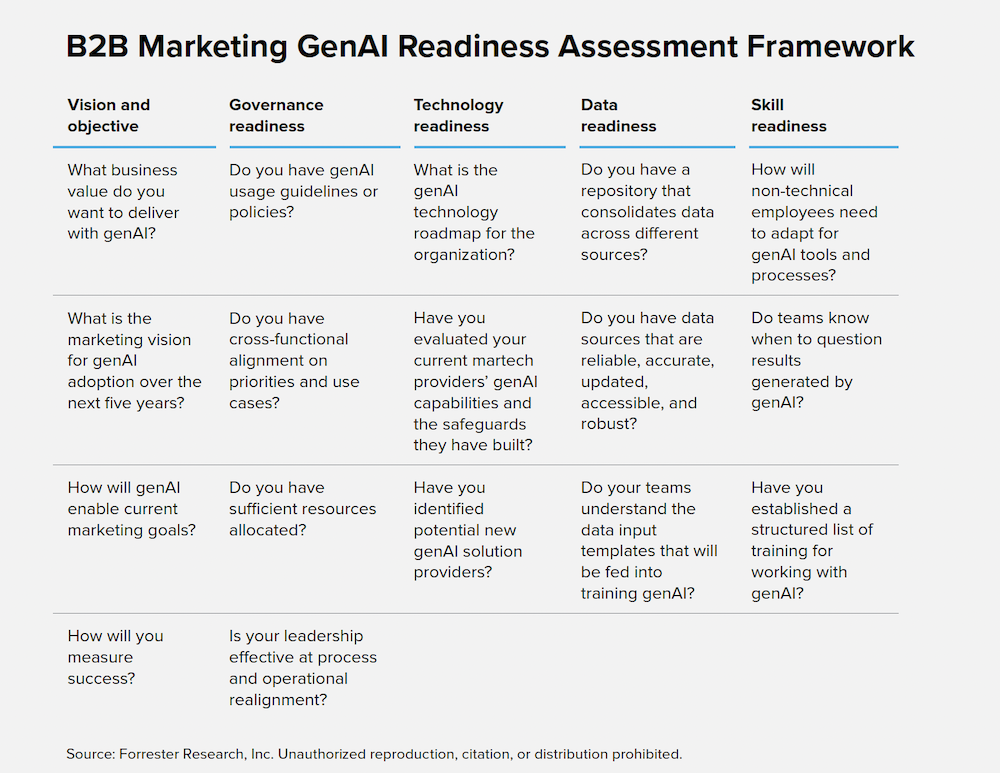Most B2B marketing teams are exploring generative AI, but only 20% are using it every day. Meanwhile, 90% of B2B buyers are leveraging gen AI at each stage of the buying process. To stay ahead, CMOs need to move from experimentation to execution — closing the gap and keeping pace with increasingly AI-driven buyers.
A new report from Forrester, “Generative AI: A Pragmatic Guide for B2B CMOs,” explains that many marketing teams are slower to incorporate gen AI into day-to-day workflows because it feels like yet another initiative.
“There’s a lot of change fatigue,” Lisa Gately, principal analyst at Forrester, explains in the report. “Without intentional change management and notching short-term wins, gen AI adoption gets deprioritized.”
The report examines some of the key missteps CMOs make in their gen AI journeys and how to avoid them.
Lacking Strategic Direction
Eager to use the technology, many marketing teams begin testing gen AI tools but aren’t sure how they fit into their organization’s long-term vision.
Before implementing gen AI, CMOs need to define exactly how the technology will accelerate their marketing function. Maybe it’s helping you fine-tune messaging, learn more about your personas or improve customer engagement through personalized experiences.
After your goals are clear, share your vision to get buy-in, clean up your data and start training your team.
Failing to Prioritize Efforts
Once you’ve ironed out your strategy, choose where to focus first. For example, you might decide to install a chatbot on your website that uses generative AI to answer visitor questions or connect them with a human representative when it can’t provide an accurate response.
Whenever you launch a new gen AI initiative, it’s important to consider how it will impact your business, your customers and your employees. At the same time, you also have to be realistic about what you hope to achieve and cognizant of risks and potential reputational impact (e.g., by publishing so-called “AI slop” — low-quality content that’s unoriginal and nonsensical — and getting called out for it).

Overlooking the Risks
Rather than simply telling their teams to use gen AI, CMOs need to understand the technology’s risks and install guardrails to protect against them. Such risks include AI hallucinations, thinking that the technology can solve strategic challenges on its own, and putting proprietary information into free versions of tools like ChatGPT and Gemini (which then use that data to train their own models).
Ultimately, gen AI is a tool just like Photoshop and Figma. Marketing leaders need to ensure that their teams understand that everybody is accountable for any AI output that’s released into the wild.
Overrelying on Gen AI
While gen AI can certainly speed up marketing workflows, it’s important to be mindful of the buyer experience. Nearly three years after ChatGPT’s public release, everyone’s aware of what AI slop looks like. Should you flood decision makers with such content, don’t be surprised if they write you off.
“There’s no question that gen AI makes it easier to create new content quickly and to verticalize, personalize and reuse content,” Gately says. “But just because you can doesn’t mean you always should. Thinly customized gen AI content can degrade the purchase experience for buyers.”
This is not to say that you shouldn’t use gen AI to create content, just that you need to be more intentional with it. By viewing the technology as more of a collaborator and less as an independent worker — and applying consistent editorial oversight to each piece — teams can increase the volume of content they produce while ensuring it’s original, accurate and persuasive.








